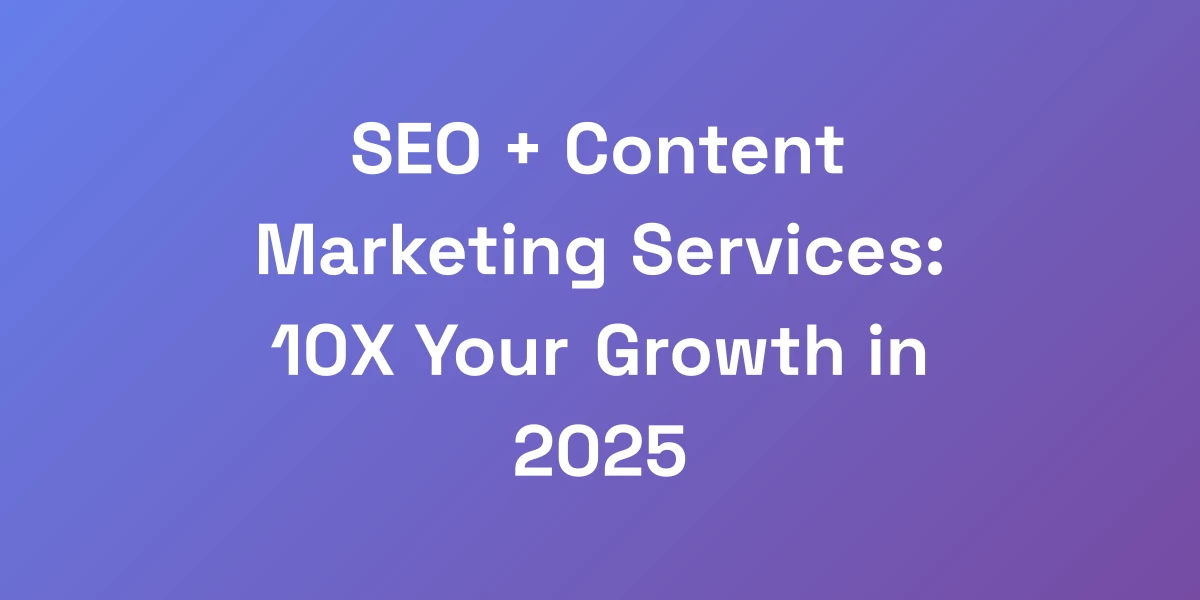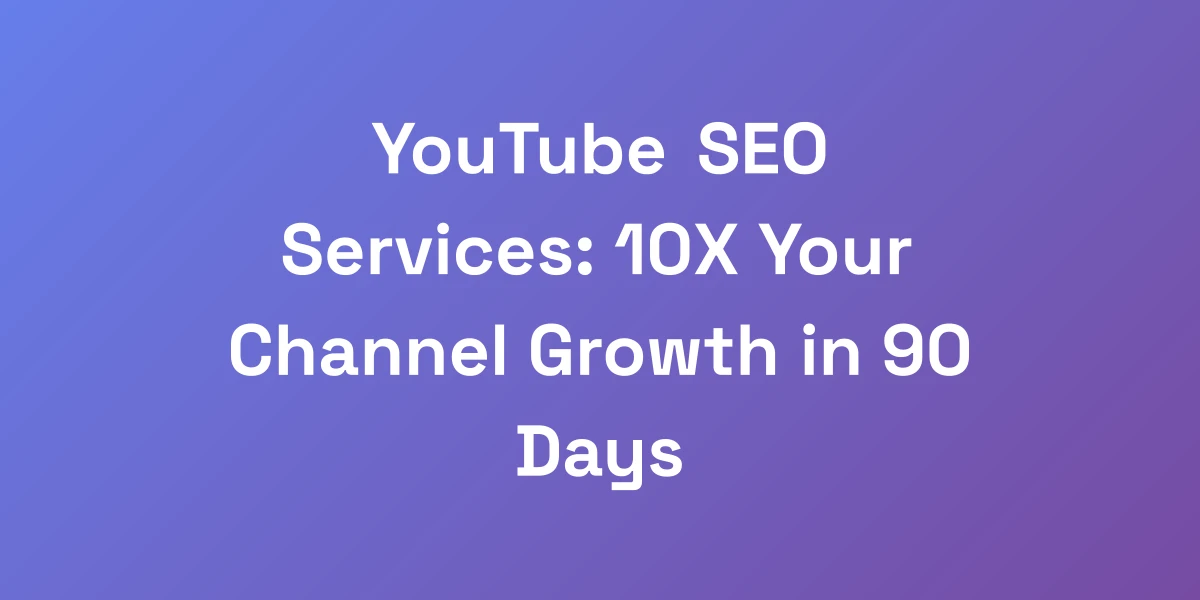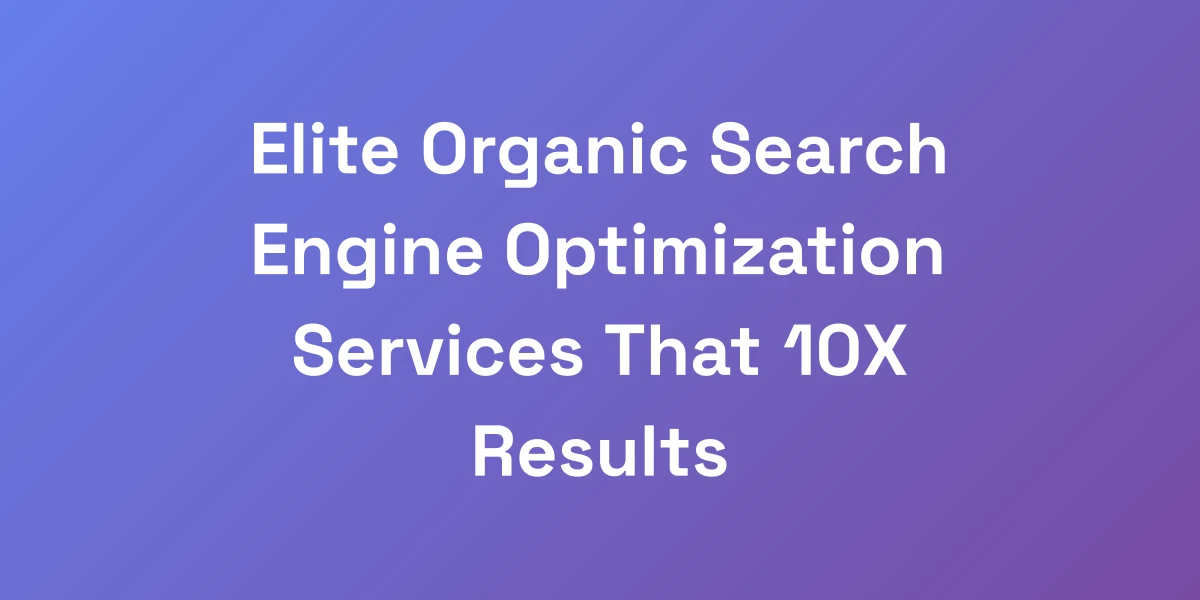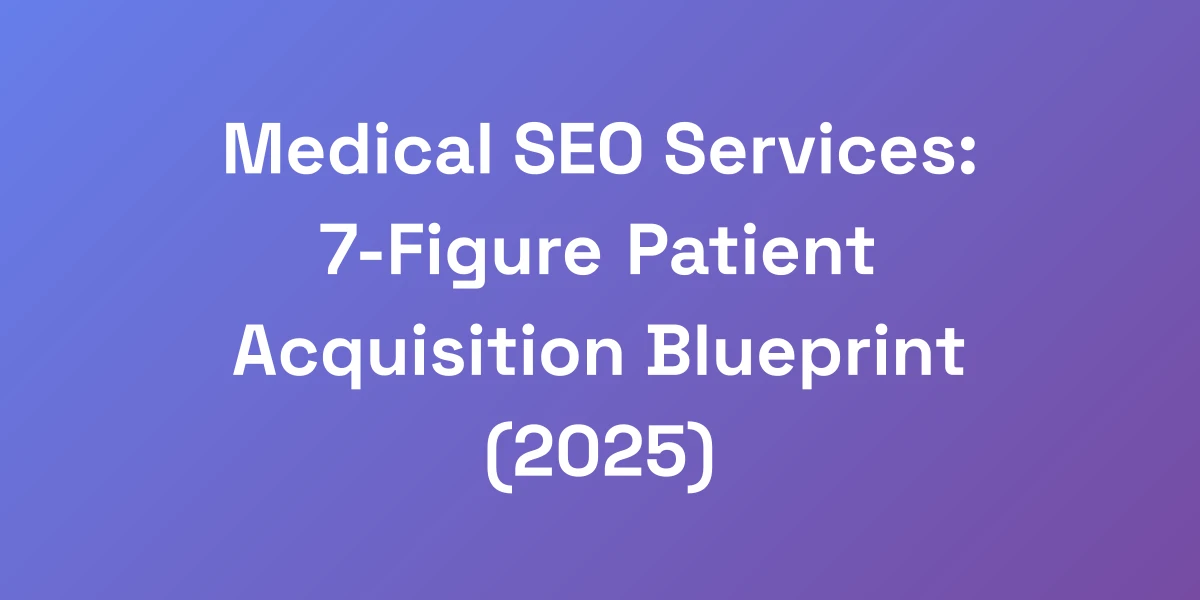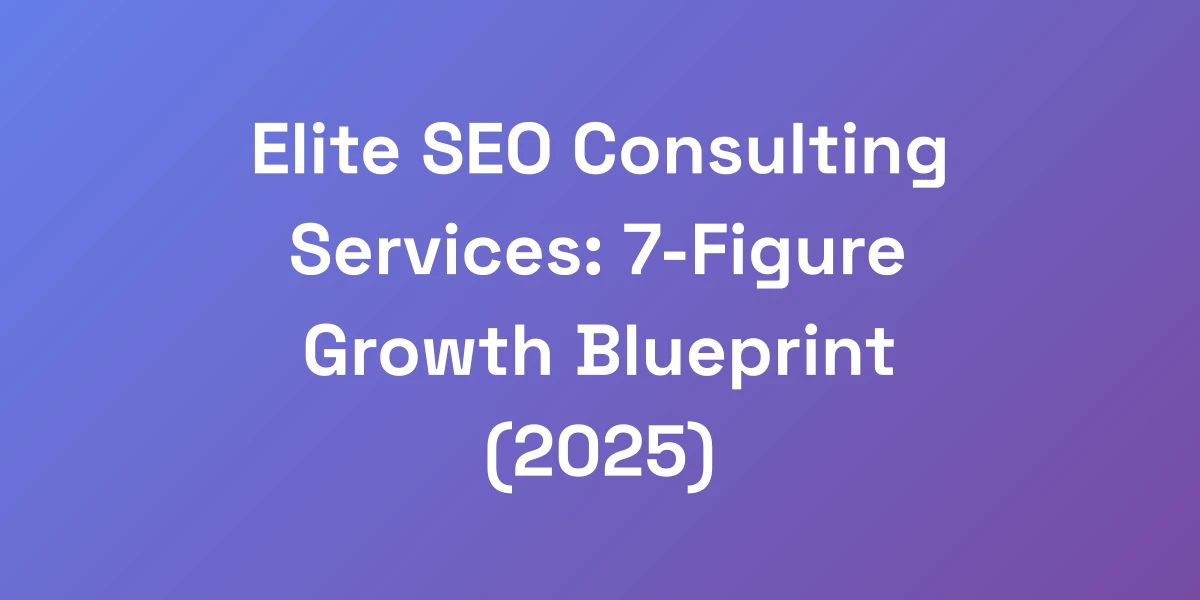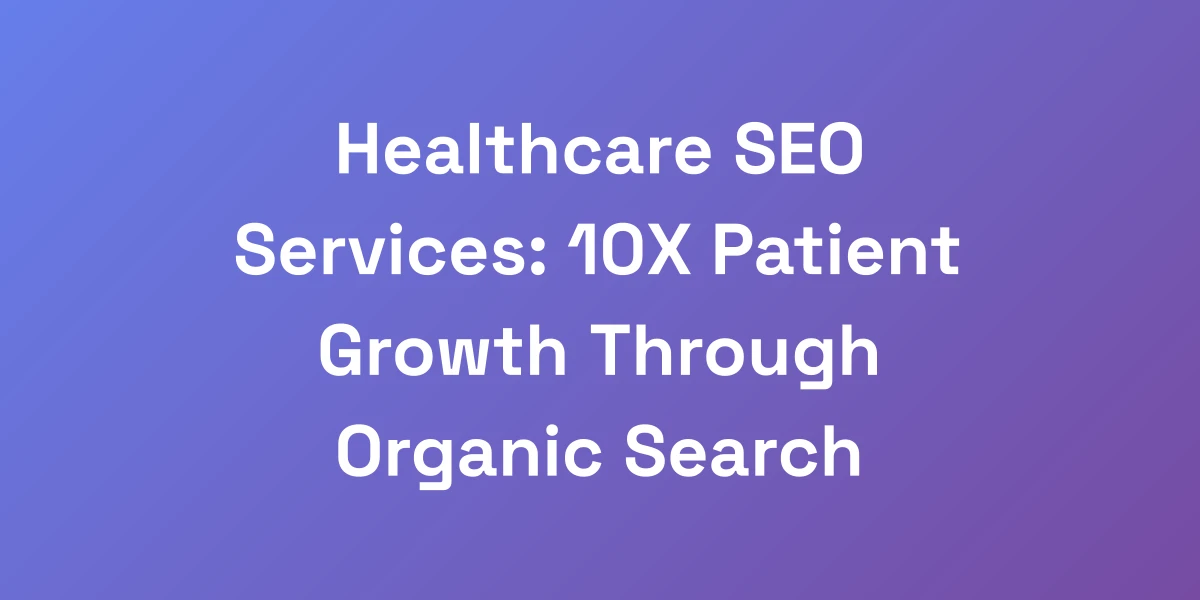
Healthcare SEO Services: 10X Patient Growth Through Organic Search
Mar 17, 2025 | By [email protected]
Why Traditional Healthcare Marketing Is Bleeding Your Practice Dry
Let’s get real about healthcare marketing in 2025. If you’re still dumping money into Google Ads and hoping for the best, you’re literally setting cash on fire.
We’ve consulted with hundreds of medical practices, and here’s the cold hard truth: most healthcare providers are overspending on advertising while underutilizing their most powerful asset – organic search visibility.
The game has changed, and those who aren’t leveraging professional healthcare SEO services are leaving millions in patient revenue on the table.
But here’s why this is actually the best news you’ll hear today…
The Hidden Cost of Pay-Per-Click in Healthcare
Pay-per-click (PPC) advertising might seem like a quick fix to attract patients, but the hidden costs often outweigh the benefits. For instance, the average Cost Per Click (CPC) in the healthcare industry ranges from $3.16 for Health Clubs & Gyms to $6.69 for Dentists & Dental Services. These numbers aren’t just statistics; they’re representing real money draining from your practice.
Moreover, the average Cost Per Lead (CPL) for healthcare businesses stands at $53.53. Imagine flipping through your monthly expenses and seeing a significant chunk allocated to PPC without a guaranteed return.
- High CPC rates increase your overall marketing budget.
- Constant bidding wars for competitive keywords eat into your profit margins.
- The lack of sustained visibility means you have to keep paying to stay in front of potential patients.
Is this sustainable? Absolutely not. PPC campaigns require ongoing investment, and once you stop paying, your visibility plummets. Organic search, on the other hand, builds lasting equity that continues to pay dividends long after the initial investment.
Why Organic Search Is Your Ultimate Patient Acquisition Channel
Organic search isn’t just about ranking #1 on Google; it’s about building a patient acquisition machine that operates tirelessly around the clock. When you invest in healthcare SEO services, you’re laying the foundation for sustained growth and increased patient trust.
Consider this: patients often research their health concerns online before taking any action. By optimizing your website for organic search, you’re positioning your practice right where patients are looking.
- Cost-Effectiveness: Unlike PPC, organic search traffic is free once your website ranks well, drastically reducing your CPL.
- Long-Term Benefits: Quality SEO builds authority over time, leading to higher rankings and more patient leads without continuous spending.
- Trust and Credibility: Organic listings are perceived as more trustworthy by patients compared to paid ads.
We’re talking about a system that not only attracts patients but pre-qualifies them before they even reach out. This means more high-value patients and less time wasted on cold leads.
The ROI Gap: SEO vs Traditional Medical Marketing
When comparing the return on investment (ROI) between SEO and traditional medical marketing, the difference is stark. Traditional methods like print ads, billboards, and even PPC campaigns often provide limited and fleeting returns.
SEO, however, offers a compounded ROI. Here’s why:
- Initial SEO investments lead to incremental traffic growth, which continues to increase as your site gains authority.
- Content marketing integrated with SEO attracts patients through valuable information, fostering long-term relationships.
- Technical optimizations ensure your website can handle increased traffic without compromising user experience.
Healthcare providers who switch to SEO report a 300-500% increase in qualified patient leads within the first year. This isn’t mere speculation; it’s a proven outcome that transforms your practice’s financial health.
Real Numbers: What Healthcare Practices Are Wasting on Ads
Let’s break it down with real numbers. The average medical practice allocates a significant portion of its marketing budget to ads, expecting immediate results. However, the reality is different:
- Hospitals & Clinics have the lowest CPL at $32.14 but spend heavily on maintaining visibility through PPC.
- Cosmetic Surgery practices spend up to $134.29 per lead, often seeing minimal returns compared to organic methods.
These expenses can severely impact your budget without delivering proportional patient growth. By shifting focus to healthcare SEO services, practices can optimize their spending and see a higher ROI through sustainable patient acquisition.
The Healthcare SEO Advantage: Beyond Basic Rankings
Here’s something that’ll blow your mind: proper healthcare SEO isn’t just about ranking #1 on Google – it’s about building a patient acquisition machine that runs 24/7.
The most successful medical practices we’ve worked with have turned their websites into lead-generating powerhouses that consistently bring in high-value patients while their competition keeps throwing money at ads.
We’re talking about a system that not only attracts patients but pre-qualifies them before they even reach out. This is the difference between playing checkers and chess in the healthcare marketing game.
HIPAA-Compliant Content Strategies That Convert
Creating content that complies with HIPAA regulations while still engaging and converting patients is a delicate balance.
Here’s how we do it:
- Educational Content: Focus on providing valuable information that addresses patient concerns without disclosing any Protected Health Information (PHI).
- Secure Communication: Use best HIPAA compliant healthcare marketing tools for secure forms and encrypted channels for patient interactions, ensuring compliance with HIPAA Privacy and Security Rules.
- Expert Authors: Content is crafted by medical professionals or under their supervision, enhancing trust and authority.
By adhering to these strategies, you can build a robust online presence that patients trust and feel safe engaging with.
Local SEO Tactics for Medical Practices
Local SEO is crucial for medical practices aiming to attract patients from their immediate vicinity. Here’s how we optimize:
- Google Business Profile (GBP) Optimization: Ensure your GBP is complete with accurate business hours, address, phone number, and categories.
- Local Keywords: Incorporate location-specific keywords to appear in search results for local queries.
- Local Citations and Reviews: Encourage patients to leave reviews and ensure consistent NAP (Name, Address, Phone) information across directories.
These local SEO tactics enhance your visibility in local search results, making it easier for nearby patients to find and choose your practice.
Building Medical Authority Through Content
Establishing your practice as a trusted authority in the medical field is paramount. Here’s how content plays a role:
- Authoritative Articles: Publish detailed, evidence-based articles on medical conditions, treatments, and wellness tips.
- Patient Testimonials: Showcase success stories and patient testimonials to build credibility and trust.
- Regular Updates: Keep your content fresh and up-to-date with the latest medical advancements and research.
By consistently producing high-quality content, your practice gains authority, which in turn boosts your SEO rankings and attracts more patients.
Technical SEO Requirements for Healthcare Websites
Technical SEO is the backbone of a successful healthcare website. Without it, even the best content won’t perform well. Here’s what needs to be in place:
- Site Speed Optimization: Ensure fast loading times to reduce bounce rates and improve user experience.
- Mobile Optimization: Most users search for healthcare services on mobile devices, so your site must be mobile-friendly.
- Secure Website (HTTPS): Protect patient data and build trust by implementing HTTPS across your site.
- Structured Data: Use schema markup to help search engines understand your content and improve visibility in search results.
These technical elements are critical for ensuring your website not only ranks well but also provides a seamless experience for visitors, leading to higher conversions. Additionally, integrating modern SEO automation tools can further enhance your technical optimization efforts, making your website more efficient and effective.
Voice Search Optimization for Medical Queries
With the rise of voice search, optimizing for natural language queries is becoming essential. Here’s how to stay ahead:
- Conversational Keywords: Incorporate long-tail keywords and natural language phrases that people use in voice searches.
- FAQ Sections: Add comprehensive FAQ sections that address common patient questions in a conversational tone.
- Local Focus: Voice searches are often local, so ensure your content includes location-specific information.
By optimizing for voice search, your practice can capture a growing segment of patients who prefer using voice assistants for their healthcare queries.
The 7-Figure Healthcare SEO Implementation Blueprint
Stop thinking about SEO as some mysterious tech voodoo. We’re about to give you the exact blueprint that has generated millions in revenue for healthcare providers.
This isn’t theory – it’s a battle-tested system that combines technical optimization, content strategy, and patient psychology.
When implemented correctly, this framework has consistently delivered a 300-500% increase in qualified patient leads within the first 12 months. And the best part? Once it’s running, your cost per patient acquisition drops dramatically while your quality of leads increases.
Initial Medical Website Audit and Optimization
Every successful SEO strategy starts with a comprehensive audit. Here’s what we focus on:
- Site Structure: Ensure your website is logically organized and easy to navigate, improving user experience and search engine crawlability.
- Content Quality: Assess existing content for relevance, depth, and compliance with HIPAA regulations.
- Technical Health: Identify and fix issues related to site speed, mobile optimization, and security to lay a solid foundation for SEO success.
By addressing these elements upfront, we ensure your website is primed for SEO growth.
Content Calendar Creation and Implementation
Consistent, high-quality content is key to maintaining and improving your search rankings. Here’s how we handle it:
- Strategic Planning: Develop a content calendar that aligns with your practice’s goals and patient needs.
- Diverse Content Types: Incorporate blog posts, patient guides, video content, and infographics to cater to different audience preferences.
- Regular Publishing: Maintain a consistent publishing schedule to keep your website fresh and engaging, which signals to search engines that your site is active and relevant.
This organized approach ensures a steady stream of valuable business blogging that attracts and retains patients.
Patient Journey Mapping and Keyword Research
Understanding the patient journey is crucial for effective SEO. Here’s how we do it:
- Journey Mapping: Identify key stages in the patient journey, from awareness to decision-making.
- Keyword Research: Conduct in-depth keyword research to find terms patients use at each stage of their journey, ensuring your content addresses their specific needs.
- Content Alignment: Align your content with the identified keywords and patient needs to ensure maximum relevance and engagement.
This targeted approach ensures your content meets patients where they are, guiding them smoothly through their decision-making process.
Link Building for Healthcare Authority
Building a strong backlink profile is essential for SEO. Here’s our strategy:
- Guest Blogging: Publish expert articles on reputable healthcare websites to earn high-quality backlinks and increase your authority.
- Professional Networking: Partner with other healthcare organizations and professionals to gain valuable backlinks through collaborations.
- Content Promotion: Share your content across relevant platforms to attract backlinks organically.
A robust backlink strategy, including link building for healthcare, not only boosts your SEO rankings but also establishes your practice as a trusted authority in the medical field.
Measuring and Scaling SEO Success
SEO is an ongoing process, and measuring its success is crucial. Here’s how we keep track:
- Key Metrics: Monitor essential KPIs such as organic traffic, lead quality, and patient acquisition cost to assess performance.
- Continuous Optimization: Regularly analyze data to identify areas for improvement and adjust strategies accordingly.
- Scaling Efforts: Once you see success, scale your SEO efforts by expanding your content, targeting new keywords, and enhancing your technical infrastructure.
Implementing SEO automation tools can enhance your tracking efficiency, ensuring sustained growth and maximizing your SEO investment.
Selecting the Right Healthcare SEO Partner
Listen, not all healthcare SEO services are created equal. We’ve seen too many practices waste 6-12 months with agencies that don’t understand the medical space.
The key is finding a partner who understands both SEO and healthcare compliance.
You need someone who can speak the language of search engines AND medical professionals. Here’s what separates the pretenders from the real deal, and why choosing the wrong partner can set you back years in your growth trajectory.
Essential Questions to Ask Healthcare SEO Agencies
Before committing to an SEO agency, ask these critical questions:
- Do you have experience with healthcare SEO?
- Can you provide case studies or references from medical clients?
- How do you handle HIPAA compliance in your SEO strategies?
- What is your approach to content creation and optimization?
- How do you measure and report SEO success?
These questions help ensure the agency has the necessary expertise and a proven track record in the healthcare sector.
Red Flags to Watch Out For
Not all SEO agencies are up to the task. Be wary of the following red flags:
- Promises of overnight results or #1 rankings without a clear strategy.
- Lack of transparency in their methods and reporting.
- Generic service packages that don’t cater to the unique needs of healthcare practices.
- No understanding of healthcare compliance and regulations.
- Poor communication and unresponsiveness during initial consultations.
These signs indicate a lack of expertise and can lead to wasted time and resources.
Understanding Service Packages and Pricing
Healthcare SEO service packages can vary widely. Here’s what to look for:
- Comprehensive Audits: Include detailed website audits to identify and fix SEO issues.
- Customized Strategies: Tailored SEO strategies that address the specific needs of your medical practice.
- Ongoing Support: Continuous optimization and support to ensure sustained SEO performance.
- Transparent Pricing: Clear and upfront pricing with no hidden fees.
Understanding what’s included in the service packages helps you choose a partner that offers real value and aligns with your practice’s goals. Additionally, consider partners who offer specialized services like SEO for startups to ensure they can scale with your practice.
Case Studies and Success Metrics to Look For
When evaluating potential SEO partners, look for agencies that can demonstrate their success through case studies and tangible metrics:
- Significant increases in organic traffic and patient leads.
- High-quality backlinks from reputable healthcare websites.
- Improved search engine rankings for relevant keywords.
- Success in maintaining compliance with healthcare regulations.
- Positive client testimonials and long-term relationships with medical practices.
These metrics provide evidence of the agency’s ability to deliver results and contribute to your practice’s growth.
Contract Terms and Performance Guarantees
Before signing on the dotted line, scrutinize the contract terms and performance guarantees:
- Clear Deliverables: Outline specific services and expected outcomes.
- Performance Guarantees: Look for agencies that offer guarantees based on performance metrics.
- Flexible Agreements: Contracts should offer flexibility to adjust strategies as needed.
- Exit Clauses: Ensure there are clear terms for terminating the contract if expectations aren’t met.
Having clear and fair contract terms protects your practice and sets the foundation for a productive partnership.
Measuring Success: Healthcare SEO Metrics That Matter
Forget vanity metrics like keyword rankings – let’s talk about the numbers that actually impact your bottom line. The only metrics that truly matter are patient acquisition cost, lead quality, and revenue generated per marketing dollar spent.
We’ll show you exactly how to track these metrics and what benchmarks you should be hitting at each stage of your SEO journey. This is about turning your website into a measurable, scalable patient acquisition system.
Key Performance Indicators for Medical SEO
Tracking the right KPIs is essential for understanding the effectiveness of your SEO efforts:
- Organic Traffic: Measure the volume of visitors coming from search engine results.
- Conversion Rate: Track the percentage of visitors who take desired actions, such as booking an appointment.
- Patient Acquisition Cost (PAC): Calculate the cost associated with acquiring a new patient through SEO efforts.
- Keyword Rankings: Monitor your rankings for crucial keywords to ensure continuous improvement.
- Backlink Quality: Assess the quality and relevance of backlinks to gauge authority and trustworthiness.
Focusing on these KPIs ensures you’re measuring the metrics that drive real growth and patient acquisition.
Patient Attribution Tracking
Understanding where your patients are coming from is crucial for optimizing your SEO strategy. Here’s how to do it:
- UTM Parameters: Use UTM codes to track the source of your website traffic and patient leads.
- CRM Integration: Integrate your SEO efforts with your Customer Relationship Management (CRM) system to track patient interactions and conversions.
- Analytics Tools: Utilize tools like Google Analytics to gain insights into patient behavior and journey on your website.
Effective attribution tracking allows you to pinpoint which SEO activities are driving patient growth, enabling data-driven decision-making.
ROI Calculation Methods
Calculating the ROI of your SEO efforts ensures you’re investing in strategies that deliver value. Here’s a simple method:
- Identify Revenue: Determine the revenue generated from new patient leads acquired through SEO.
- Calculate Costs: Add up all costs associated with your SEO campaigns, including agency fees, content creation, and technical optimizations.
- Compute ROI: Use the formula: ((Revenue – Cost) / Cost) x 100 = ROI%
Tracking ROI helps you understand the financial impact of your SEO efforts and justify ongoing investments.
Competitive Benchmarking
Understanding where you stand compared to your competitors is vital for setting realistic goals and strategies. Here’s how to approach it:
- Identify Competitors: Determine who your main competitors are in the local and broader healthcare market.
- Analyze Their SEO: Use tools to analyze competitors’ keyword rankings, backlink profiles, and content strategies.
- Set Benchmarks: Establish benchmarks based on competitors’ performance and set goals to surpass them.
Competitive benchmarking provides a clear picture of the market landscape and helps you identify opportunities for improvement and differentiation.
Monthly Reporting and Analysis
Regular reporting and analysis are essential for tracking progress and making informed adjustments. Here’s our approach:
- Monthly Reports: Receive comprehensive reports detailing key metrics, progress towards goals, and action items.
- Trend Analysis: Analyze trends over time to identify patterns and areas that require attention.
- Strategy Adjustments: Based on the analysis, tweak your SEO strategies to optimize performance and address any challenges.
Consistent reporting ensures transparency and allows for continuous improvement, keeping your SEO efforts aligned with your practice’s growth objectives.
